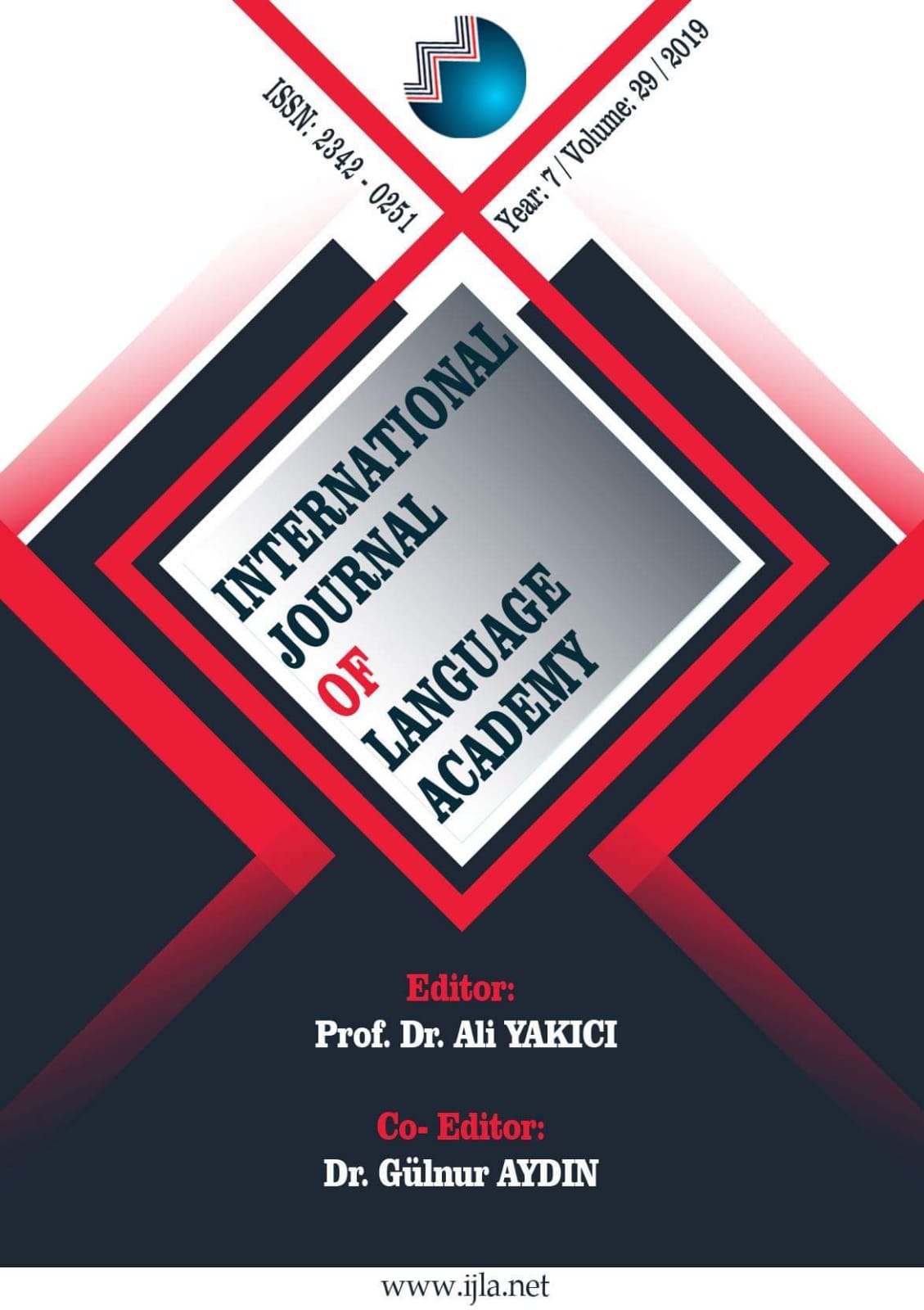Author :
Abstract
Çevirinin yabancı dil ediniminde kullanılması uzun yıllar tartışmaların merkezinde yer almıştır. Son yıllarda öğrenci merkezli eğitimin ve öğrenen stratejilerinin önem kazanmasıyla dil eğitimi ortamlarında çeviriye karşı olumsuz tutumları ortadan kaldırmak için birçok araştırma yayımlanmaktadır. Araştırmacıların öğrenen stratejilerinin öğrenme şartlarına etkisini tespit etmeleri, çeviriyi bir öğrenme stratejisi olarak kullanmanın, yabancı dil eğitimindeki etki payını araştırma kapısını aralamaktadır. Bu çalışmada, Fransızca öğrenen üniversite öğrencilerinin çeviriyi ne derecede bir öğrenme stratejisi olarak kullanma eğilimi gösterdikleri, yabancı dil öğrenenlerin kullandıkları farklı stratejilerin tespitiyle çevirinin yabancı dil öğrenmede hangi aşamalarda faydalı olabileceği sorusunun cevabı araştırılmıştır. Bu amaca yönelik olarak, Hacettepe, Gazi ve Marmara Üniversitelerinin Fransız Dili Eğitimi Anabilim Dallarında 2017-2018 yıllarında eğitim gören 136 öğrenciye Liao (2002) tarafından “The Inventory for Translation as a Learning Strategy (ITLS) adıyla geliştirilen ve tarafımızca Türkçeye uyarlanan Öğrenme Stratejisi Olarak Çeviri Ölçeği (ÖSÇÖ) uygulanmıştır. Betimsel ve karşılaştırmalı istatistiksel işlemlere tabi tutulan verilerle, ÖSÇÖ ve alt boyutlarının cinsiyet, sınıf ve başarı düzeyi gibi değişkenlere göre anlamlı farklılık gösterip göstermediği ele alınmış ve yorumlanmıştır. Araştırma, katılımcıların çoğunluğunun yabancı dil eğitiminde çeviri kullanımını bilişsel, üst-bilişsel, sosyal ve duyuşsal bir öğrenme stratejisi olarak gördüklerini ortaya koymuştur. Ayrıca, elde edilen sonuçlar, strateji kullanımının kimi zaman bir kaçma taktiği olarak ortaya çıkabileceğini kanıtlar niteliktedir. Elde edilen bulgularla çeviri derslerinin, öğrenme stratejilerine hizmet edecek şekilde yeniden tasarlanmasının mümkün olabileceği tespit edilmiş, farklı dil ve ortamlar için benzer çalışmalar yapılmasına kapı aralamak amaçlanmıştır.
Keywords
Abstract
The use of translation in foreign language acquisition has been at the center of the discussions for many years. In recent years, with the importance of student-centered education and learning strategies, many studies have been published in language education environments to eliminate negative attitudes towards translation. The determination of researchers about the effect of learners strategies on learning conditions, prepare a ground of research about the effect level of translation as a learning strategy in foreign language training. This study aimed to find answers to questions such as whether learners tend to use translation as a learning strategy and in which stages the translation can be useful in learning a foreign language, by identifying different strategies used by foreign language learner. An inventory (ÖSÇÖ- Öğrenme Stratejisi Olarak Çeviri Ölçeği) which we have adapted to Turkish is applied to 136 students studying in the French Language Education Departments of Hacettepe, Gazi and Marmara Universities in 2017-2018. We have searched and discussed whether there is a statistically significant difference between the variables such as gender, class, level of success. The data subjected to descriptive and comparative statistical procedures reveal that the majority of these students see the use of translation in foreign language education as a cognitive, metacognitive and affective learning strategy. Furthermore, the results obtained demonstrate that the use of strategy may occasionally emerge as an escape attempt. With the findings obtained, it has been found that it may be possible to redesign the translation courses to serve the learning strategies and it was aimed to pay the way for similar studies for different languages and environments.
Keywords
- Bruen, J. (2017) Language learning strategies for reading comprehension: assessing the strategy use of young adults at beginners’ level talking Chinese, German, Japanese or Spanish as foreign languages at university, The Language Learning Journal, pp. 1-17 https://doi.org/10.1080/09571736.2017.1370606 sayfasından erişilmiştir.
- Can, A. (1996). SPSS ile Bilimsel Araştırma Sürecinde Nicel Veri Analizi, Ankara: Pegem Akademi.
- Chang, C. Y., Liu, S. C., & Lee, Y. N. (2007). A study of language learning strategies used by college EFL learners in Taiwan. Mingdao Journal of General Education, 3, 235-261.
- Cohen, A.D. 1996. Second language learning and use strategies: Clarifying the issues (revised version). Paper originally prepared for presentation at the Symposium on Strategies of Language Learning and Use, December pp.13-16, 1994. Seville, Spain.
- Cyr, P., (1996), Les Strategies d’Apprentissage, CLE International, Québec.
- Dmitrenko, V. (2017). Language learning strategies of multilingual adults learning additional languages, International Journal of Multilingualism, 14 (1), 5-22. https://doi.org/10.1080/14790718.2017.1258978 sayfasından erişilmiştir.
- Liao, P. (2002). Taiwanese College Students’ Beliefs About Translation And Their Use Of Translation As A Strategy To Learn English. Dissertation, The University of Texas, Austin.
- Lunin, M., Minaeva, L. (2015). Translated Subtitles Language Learning Method: a New Practical Approach to Teaching English, Procedia - Social and Behavioral Sciences 199, 268 – 275.
- Mohammadi, M. (2009). On the Relationship between Learning Strategies and EFL Learners’ Level of Proficiency. The Journal of Modern Thoughts in Education 4 (3) pp 103-116. https://www.sid.ir/En/Journal/JournalListPaper.aspx?ID=80589
- Mollaei, F., Taghinezhad, A. & Sadighi, F. (2017). Teachers and Learners’ Perceptions of Applying Translation as a Method, Strategy or Technique in an Iranian EFL Setting. International Journal of Education & Literacy Studies. 5(2), 67-73. http://dx.doi.org/10.7575/aiac.ijels.v.5n.2p.67 sayfasından erişilmiştir.
- Naiman, N., Frohlich, M., Stern, H. H., & Todesco, A. (1978). The good language learner. Toronto: Ontario Institute for Studies in Education.
- O’Malley et al. (1985a). Learning Strategies Used by Beginning and Intermediate ESL Students. In Language Learning.
- O’Malley, J.M. & A.U. Chamot. (1990).Learning strategies in Second Language Acquisition. Cambridge: Cambridge University Press.
- Oxford, R. L. (1990). Language learning strategies: What every teacher should know. New York: Newbury House.
- Özçelik, N. (2012). Étude sur les Stratégies d’Apprentissage Utilisées par des Apprenants Universitaires en Acquisition Du FL3. e-Journal of New World Sciences Academy, 7 (4), pp.1096-1107.
- Richards, J. C. (2001). Curriculum Development in Language Teaching. Cambridge, UK: Cambridge University.
- Rubin, J. (1975). What the "good language learner" can teach us. TESOL Quarterly, 9(1), 41-51.
- Wenden, A. (1987). How to be a successful language learner: Insights and prescriptions from L2 learners. In A. L. Wenden & J. Rubin (Eds.), Learner strategies in language learning, (pp.103-118), Englewood Cliffs, NJ: Prentice-Hall.





